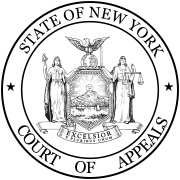| MacPherson v. Buick Motor Co. | |
|---|---|
 | |
| Court | New York Court of Appeals |
| Full case name | Donald C. MacPherson v. Buick Motor Company |
| Argued | January 24 1916 |
| Decided | March 14 1916 |
| Citation | 111 N.E. 1050, 217 N.Y. 382 |
| Case history | |
| Prior history | Judgment for plaintiff, Sup. Ct.; aff'd, 160 A.D. 55 (3d Dep't 1914) |
| Holding | |
| An automobile manufacturer's liability for a defective product extended beyond the immediate purchaser. Appellate Division affirmed. | |
| Court membership | |
| Chief judge | Willard Bartlett |
| Associate judges | Frank H. Hiscock, Emory A. Chase, William H. Cuddeback, John W. Hogan, Benjamin N. Cardozo, Cuthbert W. Pound |
| Case opinions | |
| Majority | Cardozo, joined by Hiscock, Chase, Cuddeback |
| Concurrence | (without separate opinion) Hogan |
| Dissent | Bartlett |
| Pound took no part in the consideration or decision of the case. | |
MacPherson v. Buick Motor Co., 217 N.Y. 382, 111 N.E. 1050 (1916) is a famous New York Court of Appeals opinion by Judge Benjamin N. Cardozo that removed the requirement of privity of contract for duty in negligence actions.
Facts
The plaintiff, Donald C. MacPherson, a stonecutter, was injured when one of the wooden wheels of his 1909 Buick Runabout collapsed. The defendant, Buick Motor Company, had manufactured the vehicle but not the wheel, which had been manufactured by another party but installed by defendant. It was conceded that the defective wheel could have been discovered upon inspection. The defendant denied liability because the plaintiff had purchased the automobile from a dealer, rather than directly from the defendant.
Judgment
In the earlier precedent, duty had been imposed on defendants by voluntary contract via privity as in an English case, Winterbottom v. Wright. which is the precursor rule for product liability. The portion of the MacPherson opinion in which Cardozo demolished the privity bar to recovery is as follows:
If the nature of a thing is such that it is reasonably certain to place life and limb in peril when negligently made, it is then a thing of danger. Its nature gives warning of the consequence to be expected. If to the element of danger there is added knowledge that the thing will be used by persons other than the purchaser, and used without new tests, then, irrespective of contract, the manufacturer of this thing of danger is under a duty to make it carefully. That is as far as we need to go for the decision of this case.... If he is negligent, where danger is to be foreseen, a liability will follow.
Dissent
Willard Bartlett wrote a dissenting opinion objecting to Cardozo's new rule and conclusion.
It has heretofore been held in this state that the liability of the vendor of a manufactured article for negligence arising out of the existence of defects therein does not extend to strangers injured in consequence of such defects but is confined to the immediate vendee. The exceptions to this general rule which have thus far been recognized in New York are cases in which the article sold was of such a character that danger to life or limb was involved in the ordinary use thereof; in other words, where the article sold was inherently dangerous. As has already been pointed out, the learned trial judge instructed the jury that an automobile is not an inherently dangerous vehicle.
See also
- Donoghue v Stevenson AC 562, where Lord Atkin cited the decision with approval in the House of Lords.
Notes
- Anita Bernstein The Reciprocal of MacPherson v. Buick Motor Company in De Gruyter Journal of Tort Law Vol. 9 issue 1–2 August 2016 https://doi.org/10.1515/jtl-2016-0007 Retrieved 17 August 2017
- Cited with approval by Lord Atkin in Donoghue v Stevenson UKHL 100
- Business Week article regarding the case
- Winterbottom v. Wright, 152 Eng. Rep. 402, 403 (Ex. 1842) (denying injured man's suit against manufacturer because the judge found no privity between the defendant carriage maker and the injured plaintiff),
- Arthur Best, David W. Barnes. Basic tort law: cases, statutes, and problems. p. 657.
- https://casetext.com/case/macpherson-v-buick-motor-co-2
- AC 562 at 598.
External links
| General Motors | ||||||||
|---|---|---|---|---|---|---|---|---|
| Divisions and subsidiaries |
|  | ||||||
| Shareholdings |
| |||||||
| Products and technologies |
| |||||||
| Former divisions, joint ventures and subsidiaries |
| |||||||
| Facilities | ||||||||
| People |
| |||||||
| Sponsorship |
| |||||||
| Related topics | ||||||||
This article relating to case law in the United States or its constituent jurisdictions is a stub. You can help Misplaced Pages by expanding it. |